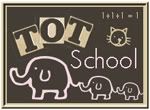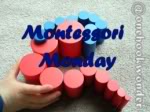This post almost did not happen. I was doing last minute editing yesterday ... I tried to add a button for one of the link-ups and my entire post disappeared for some odd reason. I was so bummed after all the time I put into researching and typing it up. Luckily, I had my blog post opened in two windows on my Mac so I quickly saved an old, unedited version before I lost the entire thing.
What I Used to Make the Game:
Color Square Tiles (Green, Blue, Red)
Bingo Chips or Colored Round Counters (same colors)
Game Pieces (same colors)
Silverware Container (eraser to separate materials)
Stamp Game Paper
Paint Stick (ruler, pencil, pipe cleaner, string, etc)
Golden Beads, Base Ten Blocks, or Math U See Blocks
Large Number Cards - FREE at Montessori Print Shop
Green, Red, Blue, and Black Colored Pencils
or
Fine Print Dry Erase Markers if you laminate stamp paper
Velcro
Note: I used velcro to attach the paint stick to the side of the stamp game so that it would not get lost.
Our Do-It-Yourself Stamp Game

Problem: Our tiles are not labeled but it did not cause any problems with Alyssa's understanding. I labeled and propped a foam tile in the compartments to indicate 1's, 10's, 100's, 1,000's. The only issue we had was when cleaning off the mat. Most of the green tiles were found in only one compartment. This was an easy fix. I told Alyssa to start with the units and place them into the units compartment and so forth when cleaning up the tiles after each addition problem. She has already internalized the meaning of each stamp tile.
Alternative Do-It-Yourself Stamp Games
Discovery Days and Montessori Moments
The Learning Ark
Introducing the Stamp Game
First, I introduced the stamp tiles using a three-period lesson. I also wanted Alyssa to associate the stamp tiles with the correct place value cards and blocks including Math U See and Base Ten Blocks. Below you will see a variety of photographs using the three-period lesson to review the blocks and to introducing the stamp tiles. These are not step-by-step photographs of the three-period lesson - if that makes sense. Montessori Training posted a You Tube video demonstrating the three-period lesson using stamp game vocabulary. You can also read about the three-period lesson at Montessori Print Shop, Living Montessori Now, and 1+1+1=1. Thank you Jennifer, Deb, and Carisa for these resources!
Number Formation
The next step for Alyssa was to work on forming numbers with the stamp tiles. I labeled foam square tiles with the letters U, T, H, and TH and asked her to place them above the correct term on the place value chart. We worked on forming smaller numbers first. I called out a single or 2-digit number and she used the stamp tiles to create the number starting with the units first. I wrote larger 3 and 4-digit numbers on index cards for her to create with the stamp tiles. I used markers to color-code the numbers written on the index cards.
Place Value Mat
The place value mat is located at ABC Teach ... this is a member only document. You can make the mat with felt or fabric and use foam letters, alphabet stickers, or markers to write or abbreviate the terms units, tens, hundreds, and thousands at the top. I ended up using opaque white paint markers and wrote on foam squares from storage because I could not find my colored foam alphabet stickers.
- Problem: The place value mat was too short. I knew that it would be a problem when we used the stamp game to add two larger numbers. We ended up using the flannel board and pipe cleaners to separate the columns in the chart. I may use ribbon, felt, painter's tape, foam, or string to separate the columns later and work towards using a board without the dividing lines. Any place value mat suggestions?
Arithmetic Operation: Addition Using the Stamp Game
Then, we reviewed the meaning of the addition symbol or "plus" sign. We also reviewed terminology related to addition such as "addends" and "sum." On the same day, we introduced static addition. Dynamic Addition will be introduced in the near future. I showed Alyssa the stamp paper and wrote a 4-digit number using the colored pencils in the correct squares. She proceeded to build the large number. I gave her a second large number to build. The last step was to remove the paint stick. The stamp tiles were pushed together and counted in order to find the sum. Alyssa recorded the sum for the addition equation on the stamp paper. I am also printing addition command cards from Montessori Print Shop so that she can work independently.
You can find the Stamp Game with instructions and printables at my absolute favorite Montessori store, Montessori Print Shop. Jennifer recently posted the ENTIRE set under her FREE resources so head on over now to download and print it! The packet also includes information on how to use the stamp game for other operations. The Moveable Alphabet and Montessori Primary Guide also describe the game in detail if you like to compare instructions. Montessori Materials offer black and white stamp tiles you can print on colored card stock to create your own game. Additionally, Karen Tyler and Montessori Album have the stamp game materials and stamp paper. Montessori Album has stamp game paper with illustrations at the top representing the golden beads on the chart.
For those of you lucky enough to own an iPad ... there is also a Stamp Game App by Montessori Tech. Oh ... how I wish I had an iPad. Sorry, I didn't mean to dreaming out loud.
I will link this post at the following blogs:














































What a great post! I loved all the photos and directions for making your own stamp game. Thanks for sharing so many great links ... and thanks for sharing the link to my 3-period lesson post! I'm so glad you linked up with Montessori Monday. I featured your post at the Living Montessori Now Facebook page: http://www.facebook.com/LivingMontessoriNow
ReplyDeleteWOW! This is very informative! I love . Thank your stamp game. Pinning to my Pinterest boards. Thanks for sharing. :)
ReplyDeleteGlad this post didn't get lost! I love the Montessori ideas. Looks like fun!
ReplyDelete